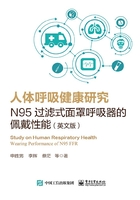
1.2 Motivation
In the past decade,air quality and its effects on health have been topics of great concern.The inhaled air pollutant PM2.5 has attracted more and more attention since it can easily enter the lower respiratory tract,causing cardiovascular diseases,respiratory irritation,and pulmonary dysfunction.Thus,good knowledge of the transport and deposition of PM2.5 in the respiratory system via inhalation is crucial to developing strategies to prevent diseases.
As an effective tool to prevent inhalation of polluted air via the human mouth and nostrils and exposure to particulate matter,N95 FFR is most commonly used for personal protection from exposure to PM.Fibrous filters are widely used as the filtration media for N95 FFR since they outperform other filtration media.The filtration performance of the fibrous filters is most commonly measured on the basis of the pressure drop and filtration efficiency,which are mainly determined by the filter's internal microstructure and gas-solid flow characteristics.Numerical simulations of gas-solid flow in various arrangements of fibrous media have been studied by many researchers.Most of these simulations use simple fibrous structures and generated two-dimensional (2D) fibrous media,while others applied heterogeneous fibrous structures and generated three-dimensional (3D) layered fibrous structures.However,these fibrous models are not based on the actual fibrous media structures and the actual performance of such fibrous media remains unclear.To improve filtration performance,it is necessary to investigate the optimized structures for various particle sizes.The effects of thickness of the fibrous media should also be studied.In addition,most previous studies investigated the particle trajectory and deposition using the ideal trapping model,which assumed that particles will be trapped on contact with a solid surface (fiber or deposited particle).It is necessary to study the interaction between the particle and fiber surface and particle filtration of disordered multi-fiber filter.
The filtering facepiece partially covers the human face,creating a cavity.Owing to the porous nature of the FFR,a pressure drop occurs in the FFR deadspace,which may cause discomfort to the wearer.The physiological effects of wearing an N95 FFR include headache,dizzy,nausea,heat,increasing heart rate,itching,etc.To completely understand the physical mechanism of discomfort it is important to investigate the CO2,humidity and temperature distributions in the FFR deadspace.Considering the complexity and high-cost of the experiments,the computational fluid dynamics (CFD) provides an alternative low-cost but effective means to conduct such an investigation.CFD uses numerical methods to solve fluid problems and obtain information about velocity,pressure,and temperature.Previous researches simulated the air flow in the FFR cavity using the CFD method,and some have even used the CFD method to determine the position of face seal leaks while wearing FFR.However,most researches used simplified human models to conduct a simulation.Therefore,it is necessary to construct more accurate representations of the headform as well as the respirator.Computed tomography (CT) and magnetic resonance imaging (MRI) are good modalities for this purpose.By using CT and MRI,we can discern not only the structure of the human head but also of the airway.Thus,air flows and particle movement in the airway can be simulated at the same time.It is also necessary to simulate the vapor condensation of microclimate in the deadspace because that bacteria on the internal surface of the respirator may grow in an uneven distribution.
In order to lower the deadspace temperature and CO2 level,effective measures should be developed.One such measure could be the addition of an inward-blowing ventilation fan to the respirator.It would be worthwhile to examine various strategies to improve CO2 concentration and temperature distribution in such an improved FFR.Another important parameter for FFR is wearing fit.Bad fitness may cause air leakage,thereby decreasing the protective efficacy of the respirator.Thus,contact characteristics such as contact pressure and the resultant deformation of human face need to be determined because relatively high contact pressures and deformation may cause uneven distribution of force.Wearers may perform exercises,including normal breathing without talking,deep breathing,moving the head side to side,moving the head up and down,talking,grimacing by smiling or frowning,bending at the waist and normal breathing.The nature of contact between the respirator and human face during changes in facial expression may differ greatly from that in a static situation.Thus,it is meaningful to study the effects of four typical facial expressions (calmness,happiness,sadness and surprise) on the contact characteristics between a respirator and a headform.
In recent years,air humidifiers are widely used by numerous families or offices to increase indoor air humidity.However,the effects of air humidifiers on indoor air quality and micro-climate around a human body remain unknown.It is urgent to study the effects of air humidifiers before evaluating whether they are useful.